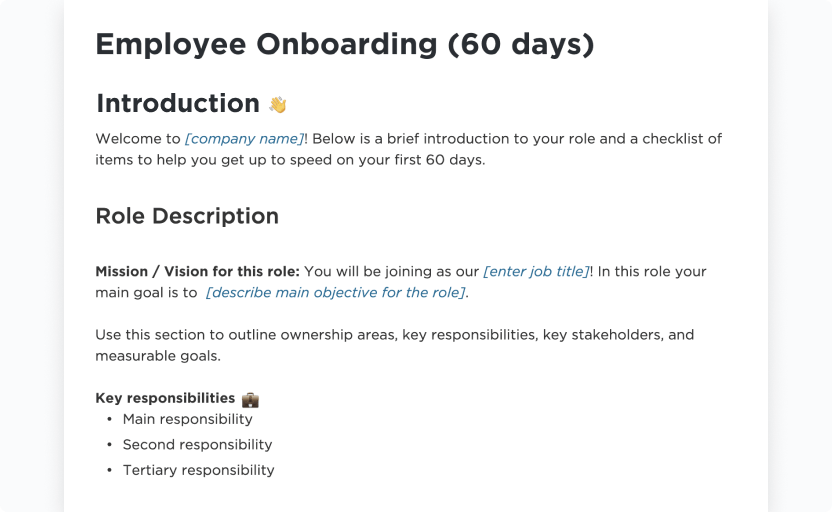هل تتذكر أول يوم لك في العمل؟ المحادثات الصغيرة المحرجة، والتردد بين طرح الأسئلة أو التظاهر بأنك فهمت كل شيء؟
يشعر موظفوك الجدد بنفس الشعور. إنهم يدخلون المكتب، آملين في ترحيب حار، لكنهم يتساءلون في صمت: "هل سأكون مناسبًا هنا؟"
تقدم لك هذه المقالة خطة تفصيلية حول كيفية الترحيب بالموظف الجديد وجعله يشعر بأنه "لقد اتخذت القرار الصحيح!"
بالإضافة إلى ذلك، سنشارك أكثر من 20 نموذجًا لرسائل الترحيب بالفريق (من الرسائل الودية إلى الرسائل الاحترافية) لتجعل الموظفين الجدد يشعرون بالدعم والحماس لكونهم جزءًا من فريقك.
لماذا من المهم الترحيب بالموظف الجديد بشكل لائق؟
الترحيب الرائع هو ما يمنح أهدافك في مجال التمهيد بداية قوية. وإليك السبب:
🌼 يتذكر الناس كيف جعلتهم يشعرون: بعد فترة طويلة من نسيانهم كلمة مرور شبكة Wi-Fi أو مكان العثور على وثيقة سياسة الموارد البشرية، سيتذكر الموظفون الجدد مقدمة لطيفة أو هدية صغيرة أو حتى رسالة ترحيب دافئة "نحن سعداء جدًا بوجودك هنا".
🌼 الأماكن الآمنة تشجع على طرح الأسئلة: مع رسالة ترحيب مكتوبة جيدًا، من المرجح أن يتحدث الموظفون بصراحة، ويطرحوا الأسئلة، ويقدموا أفكارًا جديدة، ويعترفوا عندما يواجهون صعوبات. هذه الصراحة ثمينة في الأيام الأولى.
🌼 ثقافتك تتحدث بصوت أعلى من صفحة الوظائف الخاصة بك: عندما يأخذ الفريق بأكمله الوقت للترحيب بالموظف الجديد أو تناول الغداء معه، فإن هذا يظهر أن هذه المجموعة من الأشخاص يهتمون ببعضهم البعض؛ باختصار، هذا يعكس ثقافة شركتك.
🌼 الزخم مهم: الموظفون الجدد الذين يتم الترحيب بهم بشكل مدروس يشعرون أنهم بالفعل جزء من شيء جيد. وتنعكس هذه الطاقة في عملهم وثقتهم ومساهمتهم.
🌼 يبدأ التجاهل بالصمت: في بعض الأحيان، يقبل الموظفون الجدد العرض ثم يختفون، مما يشير إلى عدم وجود صلة بين العرض وتاريخ بدء العمل. يمكن لرسالة سريعة قبل بدء العمل للموظفين الجدد سد هذه الفجوة وبناء التوقعات بدلاً من الشكوك.
👀 هل تعلم؟ وفقًا لـ SHRM، فإن الترحيب المنظم يحسن من معدل الاحتفاظ بالموظفين الجدد، ويزيد احتمال بقاء الموظفين لمدة ثلاث سنوات بنسبة 69٪. كما أنه يعزز الوضوح والثقة والالتزام والإنتاجية.
تحدد رسالة الترحيب الحارة والشخصية نغمة العلاقة، وتطمئنهم على صحة قرارهم بالانضمام، وتظهر تقديرًا حقيقيًا لهم.
⭐ نموذج مميز
يوفر نموذج قائمة مراجعة الترحيب في ClickUp قائمة مهام كاملة يمكنك إعادة استخدامها وتكييفها عبر الأدوار والأقسام عند ضم أعضاء جدد إلى الفريق. لماذا تستخدم هذا النموذج؟ لأن توحيد عمليات الموارد البشرية يقلل من احتمالات إغفال خطوات مهمة ويوفر وقت مديري التوظيف.
لنفترض أنك تقوم بتدريب موظفين جديدين: أحدهما في قسم التسويق والآخر في قسم الهندسة. باستخدام الحقول المخصصة، يمكنك تسجيل المسمى الوظيفي (على سبيل المثال، "أخصائي محتوى" أو "مطور خلفي") والقسم والبريد الإلكتروني الخاص بالعمل وتاريخ البدء الرسمي. أو قم بتضمين اسم العلامة المفضل، مثل "جيس" بدلاً من "جيسيكا"، حتى تبدو الاتصالات أكثر شخصية.
كيف ترحب بموظف جديد في الفريق؟
إن الترحيب بموظف جديد يتعلق بالاهتمام بالتفاصيل الصغيرة. دعونا نحلل ذلك.
1. أرسل بريدًا إلكترونيًا قبل البدء
فكر في البريد الإلكتروني الذي ترسله قبل بدء العمل على أنه أول رسالة ترحيب ترسلها قبل بضعة أيام (أو أسبوع) من بدء العضو الجديد في الفريق رحلته المثيرة رسميًا. وهي تخدم أغراضًا متعددة: فهي تظهر له أنك متحمس لوصوله، وتساعده على الاستعداد لرحلة ناجحة في المستقبل، وتخفف من قلقه في اليوم الأول.
📩 ما يجب تضمينه في رسالة البريد الإلكتروني الترحيبية قبل البدء:
- تاريخ ووقت الانضمام
- عنوان المكتب، وتفاصيل وقوف السيارات/النقل، وقواعد اللباس، وتعليمات اليوم الأول
- المستندات التي يجب إحضارها (بطاقة الهوية، النماذج)، بيانات تسجيل الدخول، والأدوات/البرامج التي سيستخدمونها
- جدول أعمال اليوم الأول أو جدول توجيه الموظفين الجدد
- نظرة عامة على الدور والمسؤوليات والمدير المباشر
- مقدمة عن الفريق وملخص ثقافة الشركة، ودليل، والسياسات، والقيم
💭 تذكر ما يلي: يمكن لرسالة مدروسة بعد قبول عرض العمل أن تبدأ رحلة مشاركة الموظف قبل يومه الأول بوقت طويل.
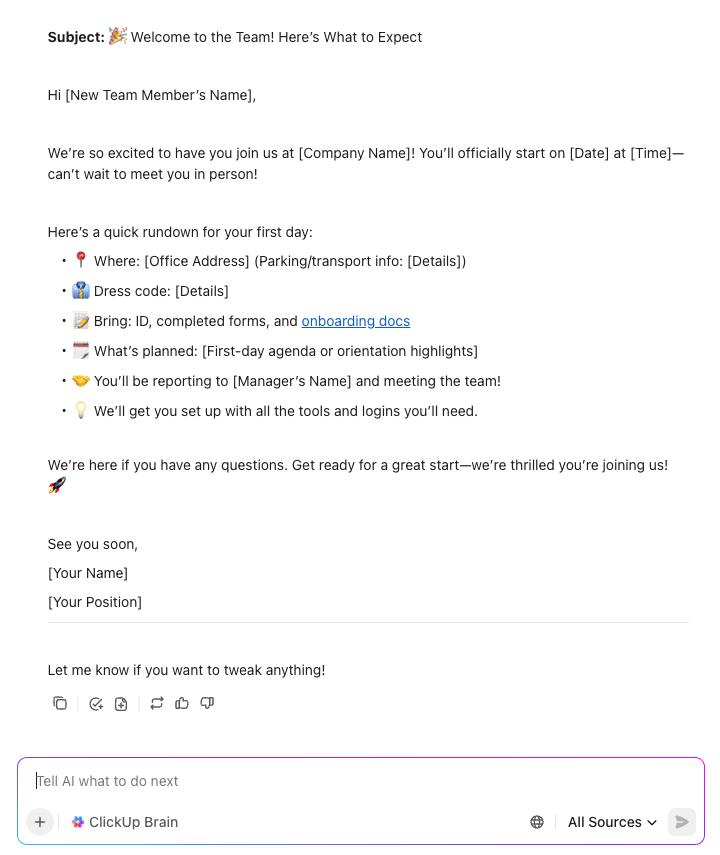
2. قم بإعداد مساحة العمل والأدوات الخاصة بهم
يأتي الموظف الجديد إلى العمل، جاهزًا للبدء، ولكنه ينتهي به الأمر إلى انتظار قسم تكنولوجيا المعلومات، والبحث عن كلمات المرور، أو عدم التأكد من مكان جلوسه. لهذا السبب، فإن إعداد مساحة العمل مسبقًا يساعده على الاستقرار بسرعة والتركيز على التواصل مع الفريق.
💼 إليك ما يجب إعداده مسبقًا:
- تجهيز المكتب أو العمل عن بُعد (نظيف ومنظم ومُصنف إذا كان في المكتب)
- كمبيوتر محمول أو مكتبي مزود بجميع الأدوات الأساسية وبرامج التدريب
- الوصول إلى البريد الإلكتروني وبرامج الاتصال والتقويمات والأدوات الداخلية الرئيسية
- إنشاء أو الوصول إلى VPN والأذونات للأنظمة الداخلية
- منتجات الشركة (مجموعة الترحيب، دفاتر الملاحظات، القمصان، زجاجات المياه)
- الوصول إلى محركات الأقراص المشتركة والمجلدات وروابط الوثائق
- بطاقة ترحيب موقعة من الفريق أو لافتة في محطة عملهم تقول "مرحبًا، [الاسم]!"
أحد التحديات الرئيسية التي يجب تجنبها في هذه المرحلة هو إرهاق الموظفين الجدد بالمعلومات في الأيام الأولى.
بطبيعة الحال، تريد أن تزودهم بالمعلومات اللازمة لبدء عملهم؛ وآخر ما تريده هو إرباكهم بكمية زائدة من المعلومات. أحد الحلول هنا هو الاستلهام من Nordstorm. فهم يشاركون ملف PDF مكون من 30 صفحة يشرح جميع المعلومات بالتفصيل.
3. قدمهم إلى الفريق
لا تترك التعارف للصدفة. خذ زمام المبادرة وقدم الموظف الجديد إلى أعضاء الفريق الرئيسيين، مثل زملاء الفريق المباشرين، والشركاء متعددي الوظائف، ومديرهم، والرئيس التنفيذي (إن أمكن).
هذا يمنحهم وضوحًا بشأن من يفعل ماذا ومن يتواصلون معه، ويبني علاقة مبكرة مع الأشخاص الذين سيتفاعلون معهم أكثر.
🤝 نصائح لتقديمات ذات مغزى:
- حدد موعدًا لعقد اجتماع سريع للترحيب بالفريق أو اجتماع صباحي في اليوم الأول
- قم بجولة تعريفية حيث يشارك كل زميل في الفريق دوره وحقيقة ممتعة عنه.
- شارك سيرة ذاتية قصيرة عن الموظف الجديد في سلسلة المحادثات أو البريد الإلكتروني، بما في ذلك معلومة ممتعة. يمكن أن تكون هذه معلومات جيدة لبدء المحادثة التي يمكن للزملاء التحدث عنها.
- اصطحبهم في جولة في المكتب بأكمله، أو اقرنهم بزميل يمكنه تقديمهم بشكل عفوي أثناء الغداء أو الدردشة.
🎨 إبداع مبتكر: جرب أفكارًا إبداعية مثل صور GIF الترحيبية المخصصة أو الملاحظات المكتوبة بخط اليد أو قوائم التشغيل الخاصة بالتأهيل لترك انطباع إيجابي لا ينسونه.
إليك نموذج لمساعدتك في جعلها ممتعة ومدروسة! 👇🏼
4. قم بتعيين صديق أو مرشد
الرفيق هو موظف متطوع يدعم الموظف الجديد خلال الأسابيع القليلة الأولى.
عادةً ما يكونون من نفس الفريق أو نفس الدور الوظيفي، أو من قسم آخر، إذا كنت ترغب في تقديم تعرض متعدد الوظائف. بالإضافة إلى ذلك، فهم على دراية بسير عمل الفريق والأدوات الداخلية والمعرفة غير الرسمية التي تساعد الموظف الجديد على الاستقرار بشكل أسرع.
🫂 نصائح لإنشاء نظام رفقاء فعال:
- حدد مواعيد منتظمة للتواصل: قم بإجراء محادثات قصيرة يومية في الأسبوع الأول، ثم كل أسبوعين أو حسب الحاجة للكشف عن المشكلات في وقت مبكر.
- شجع على المراقبة: دع الموظف الجديد يراقب الاجتماعات أو المهام التي يتولاها زميله. إذا اختلفت الأدوار، يمكن للزميل أن يطلعه على يوم عمل عادي ليوضح له كيف تعمل الشركة.
- التكامل الاجتماعي: يجب على الأصدقاء دعوتهم للانضمام إلى المحادثات الجماعية والتأكد من أنهم لا يتناولون الطعام بمفردهم، ما لم يرغبوا في ذلك.
- الإرشاد (إن أمكن): إذا كنت تعمل كمرشد، فساعد الموظفين على تحديد أهدافهم المهنية، وقدم لهم ملاحظات مبكرة، وربطهم بأصحاب المصلحة الرئيسيين خارج فريقهم.
🧠 حقيقة ممتعة: Netflix هو مثال رائع على ذلك. يشارك Cecili Reid، الذي انضم إلى Netflix كمهندس برمجيات، تجربته في الانضمام إلى الشركة في منشور شخصي على Medium:
"عندما فتحت بريدي الإلكتروني في اليوم الأول، تلقيت خطة انضمام من زميلي في الانضمام. زميل الانضمام هو شخص مخصص في فريقي يرشد الموظفين الجدد أثناء انضمامهم. تم تخصيص خطة الانضمام لفريقي ولي، وتضمنت مواد يجب أن أقرأها أو أشياء مطلوبة يجب أن أفعلها للحصول على بيانات الاعتماد الخاصة بي وإعداد بيئتي أو اقتراحات لجعل انضمامي أكثر سلاسة. عملت على الخطة في وقت فراغي بين اجتماعات الفريق أو جلسات التمهيد، وكنت ألتقي بصديقي المخصص للتأهيل يوميًا. كان صديقي والخطة ضروريين لمساعدتي في تحديد ما أحتاج حقًا إلى التركيز عليه أثناء فترة التأهيل."
🎯 نصيحة لزيادة الإنتاجية: قم بتبسيط عملية التدريب من خلال إعداد نظام الأصدقاء ومجموعة الترحيب مسبقًا. فهذا يضمن انتقالًا سلسًا ويسمح للفريق بالتركيز على تحقيق إنجازات مذهلة.
لكن لا يجب أن يكون الرفيق بشريًا. 😉يمكنك أيضًا إعداد وكيل إجابات أوتوبيلوت للموظفين الجدد، والذي يمكن تهيئته خصيصًا لمساعدتهم في الأسئلة المتعلقة بالتأهيل.
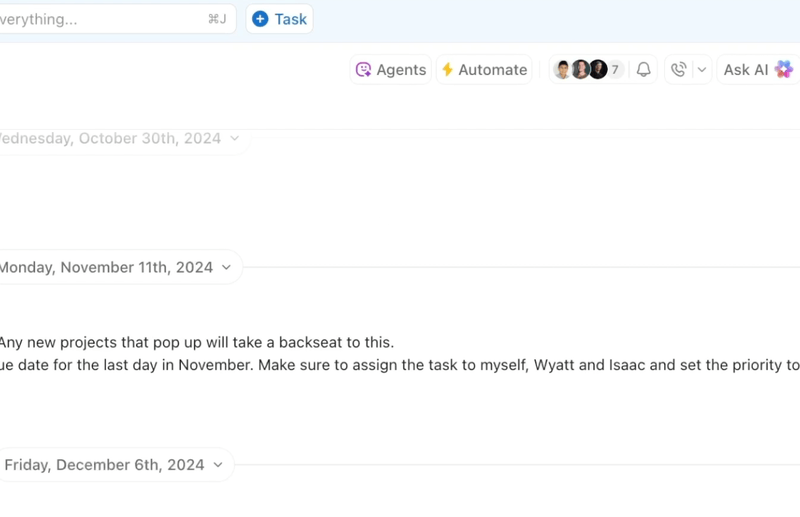
5. شارك خطة 30-60-90 يومًا
خطة 30-60-90 يومًا هي وثيقة تقسم انضمام الموظف الجديد إلى ثلاث مراحل: أول 30 يومًا، و60 يومًا، و90 يومًا.
تم وضع هذه الخطة من قبل مدير التوظيف، وهي تساعد على:
- حدد توقعات واضحة لكل مرحلة
- قدم معالم قابلة للقياس لتتبع التقدم المحرز
- قم بمواءمة جهود الموظف مع أهداف الفريق والشركة
| الجدول الزمني | التركيز | الأهداف |
| الأيام 1-30 | تعلم وراقب | – إنهاء وحدات التدريب ودورات الامتثال – قراءة سياسات الشركة والإقرار بها – إعداد الحسابات والأدوات والانضمام إلى النظام – جدولة اجتماعات فردية مع المدير وزملاء الفريق – مراقبة مكالمات الفريق وتوثيق العمليات الرئيسية – إكمال مهمة منخفضة المخاطر (على سبيل المثال، تحديث مستند داخلي، متابعة البريد الإلكتروني) |
| الأيام 31-60 | ابدأ المساهمة | – التعامل بشكل مستقل مع المهام الأساسية أو تفاعلات العملاء – تولي مسؤولية مشروع صغير أو جزء من مشروع أكبر – تحقيق 50-70٪ من مؤشرات الأداء الرئيسية المستهدفة (على سبيل المثال، عدد تذاكر الدعم التي تم حلها) – المشاركة في اجتماعات الفريق بتقديم المساهمات أو التحديثات |
| الأيام 61-90 | تحمل المسؤولية | – إدارة مشروع كامل من البداية إلى النهاية – تحقيق 100٪ من توقعات الأداء – توثيق ومشاركة الدروس المستفادة أو التحسينات مع الفريق – قيادة اجتماع أو عرض تقديمي أو تدريب داخلي |
لإنشاء هذه الخطة، يمكنك استخدام نموذج خطة 30-60-90 يومًا من ClickUp لتحديد الأهداف والنتائج والمراحل المهمة لكل مرحلة. يربط هذا النموذج بين التخطيط والتنفيذ — قم بتعيين المهام إلى عضو معين في الفريق باستخدام حقل "المسؤول" المخصص وقم بتصنيف كل مهمة بناءً على الجدول الزمني باستخدام "مرحلة الانضمام".
يحتوي النموذج على عرض لوحة، والذي يحول جميع مهام الترحيب إلى سير عمل على غرار كانبان.
قم بتخزين جميع مستندات الترحيب في عرض المراجع لسهولة الوصول إليها. هناك نماذج للمستندات، مثل العقود والروابط المفيدة وعطلات الشركة وغيرها، لمساعدتك على البدء، ويمكنك إضافة المزيد، مثل مواد التدريب وسياسات الشركة، حسب الحاجة.
⚡ أرشيف القوالب: قوالب مجانية لجدول توجيه الموظفين
6. تنظيم غداء أو قهوة ترحيبية
خطط لتناول الغداء أو القهوة مع الفريق في أول يوم عمل للموظف الجديد، أو في أول يوم جمعة في مطعم محلي مفضل. كما يمكنك تغطية تكاليف وجبتهم أو اتباع نظام الدفع الفردي، حسب ثقافة العمل لديك.
🍕 نصائح لجعل الأمر سهلاً وممتعًا:
- احجز وقتًا في تقويم الجميع خلال الأسبوع الأول للموظف الجديد
- اختر مكانًا يمكن للناس التحدث فيه (تجنب الأماكن الصاخبة أو المزدحمة). إذا كنت تعرف تفضيلاتهم الغذائية، فخذ ذلك في الاعتبار.
- لا يمكنك الخروج؟ اطلب بيتزا أو أحضر الغداء إلى المكتب
- إذا لم يكن من الممكن تناول الغداء، احضر بعض المعجنات والقهوة واجتمع في صالة أو غرفة اجتماعات لمدة 30 دقيقة من المحادثة غير الرسمية.
- بالنسبة للفرق البعيدة، قم باستضافة محادثة افتراضية حول فنجان قهوة على Zoom أو Teams. يحضر كل شخص مشروبًا ويشارك في المكالمة. ستحصل على نقاط إضافية إذا أرسلت لهم صندوقًا من الوجبات الخفيفة أو بطاقة هدية Uber Eats.
⚡ أرشيف القوالب: إذا كنت تريد إنشاء عمليات موارد بشرية قابلة للتكرار، نوصيك باستخدام قوالب ونماذج موارد بشرية معدة مسبقًا لهذا الغرض. فقط تأكد من أنها قابلة للتخصيص وفقًا لحالة الاستخدام والعمليات والمستندات الخاصة بك.
7. أضفهم إلى مساحة عمل مخصصة للتأهيل
ابدأ بإنشاء مساحة عمل مركزية للتأهيل تشمل:
بدء عمل جديد أمر مربك بما فيه الكفاية. لا تجعل الموظفين الجدد يبحثون عن معلومات الترحيب بالموظفين في رسائل البريد الإلكتروني ومجلدات Google Drive العشوائية لبدء العمل.
- المستندات الأساسية: قم بإنشاء وتخزين المستندات الأساسية مثل دليل الموظف، وأدلة التدريب، وإرشادات إعداد تكنولوجيا المعلومات، ونظرة عامة على المشاريع، وسياسات الشركة، والأسئلة الشائعة، ومسرد المصطلحات والأختصارات الداخلية.
- مهام التدريب: قم بتعيين وحدات تدريبية مثل التدريب على الامتثال، أو التعلم الإلكتروني القائم على الأدوار، أو جلسات الأمان كمهام فردية مع تعليمات واضحة ومواعيد نهائية.
- قوائم مراجعة الموظفين الجدد : أضف قائمة مراجعة للأمور الأساسية مثل ملء نماذج الموارد البشرية، وإعداد الإيداع المباشر، وإكمال تدريب السلامة، أو الاجتماع مع الرئيس التنفيذي. يمكن للموظفين الجدد تحديد كل بند أثناء قيامهم به.
- التقويم: قم بتمييز التواريخ المهمة مثل جلسات التوجيه ومواعيد التدريب ووجبات الغداء الترحيبية وجلسات المتابعة بعد 30 و60 و90 يومًا. أضف أيضًا الأحداث المتكررة، مثل المكالمات الأسبوعية للترحيب بالموظفين الجدد أو اللقاءات الشهرية للتعارف.
إليك كيف نفعل ذلك في Clickup:
بصفتي قائدًا هندسيًا في ClickUp، فإن أحد أكبر التحديات التي واجهتها هو جعل عملية الترحيب أسرع وأكثر سهولة وقيمة (لكل من المديرين والموظفين الجدد). لسنوات طويلة، كانت عملية الترحيب بالمهندسين الجدد بطيئة وغير فعالة في كثير من الأحيان، ولكن ClickUp AI غيرت ذلك تمامًا. إليك كيف أحدثنا ثورة في عملية الترحيب في ClickUp:
𝟭. 𝗔𝗴𝗴𝗿𝗲𝗴𝗮𝘁𝗲𝗱 𝗞𝗻𝗼𝘄𝗹𝗲𝗱𝗴𝗲 𝗶𝗻 𝗢𝗻𝗲 𝗣𝗹𝗮𝗰𝗲: يجمع ClickUp AI جميع الوثائق والدردشات والاستعراضات ذات الصلة بالتدريب، مما يضمن حصول الموظفين الجدد على كل ما يحتاجونه في متناول أيديهم.
𝟮. 𝗜𝗻𝘁𝗲𝗿𝗮𝗰𝘁𝗶𝘃𝗲 𝗤&𝗔 𝗳𝗼𝗿 𝗥𝗲𝗮𝗹-𝗧𝗶𝗺𝗲 𝗟𝗲𝗮𝗿𝗻𝗶𝗻𝗴: بدلاً من البحث في المستندات القديمة، يمكن للمهندسين الجدد طرح أسئلة داخل ClickUp والحصول على إجابات مدعومة بالذكاء الاصطناعي ومراعية للسياق على الفور.
𝟯. 𝗖𝗼𝗱𝗲𝗯𝗮𝘀𝗲 𝗙𝗮𝗺𝗶𝗹𝗶𝗮𝗿𝗶𝘇𝗮𝘁𝗶𝗼𝗻: توفر الذكاء الاصطناعي ملخصات لمكونات الكود الرئيسية ونظرة عامة على البنية، مما يقلل من الوقت الذي يقضيه المهندسون في محاولة فهم بنية قاعدة الكود.
𝟰. 𝗣𝗲𝗿𝘀𝗼𝗻𝗮𝗹𝗶𝘇𝗲𝗱 𝗟𝗲𝗮𝗿𝗻𝗶𝗻𝗴 𝗣𝗮𝘁𝗵𝘀: باستخدام ClickUp AI، ننشئ تجارب تهيئة مخصصة بناءً على دور كل مهندس، مما يساعدهم على المساهمة في أسبوعهم الأول.
بصفتي قائدًا هندسيًا في ClickUp، فإن أحد أكبر التحديات التي واجهتها هو جعل عملية الترحيب أسرع وأكثر سهولة وقيمة (لكل من المديرين والموظفين الجدد). لسنوات طويلة، كانت عملية الترحيب بالمهندسين الجدد بطيئة وغير فعالة في كثير من الأحيان، ولكن ClickUp AI غيرت ذلك تمامًا. إليك كيف أحدثنا ثورة في عملية الترحيب في ClickUp:
𝟭. 𝗔𝗴𝗴𝗿𝗲𝗴𝗮𝘁𝗲𝗱 𝗞𝗻𝗼𝘄𝗹𝗲𝗱𝗴𝗲 𝗶𝗻 𝗢𝗻𝗲 𝗣𝗹𝗮𝗰𝗲: يجمع ClickUp AI جميع الوثائق والدردشات والاستعراضات ذات الصلة بالتأهيل الوظيفي، مما يضمن حصول الموظفين الجدد على كل ما يحتاجونه في متناول أيديهم.
𝟮. 𝗜𝗻𝘁𝗲𝗿𝗮𝗰𝘁𝗶𝘃𝗲 𝗤&𝗔 𝗳𝗼𝗿 𝗥𝗲𝗮𝗹-𝗧𝗶𝗺𝗲 𝗟𝗲𝗮𝗿𝗻𝗶𝗻𝗴: بدلاً من البحث في المستندات القديمة، يمكن للمهندسين الجدد طرح أسئلة داخل ClickUp والحصول على إجابات مدعومة بالذكاء الاصطناعي ومراعية للسياق على الفور.
𝟯. 𝗖𝗼𝗱𝗲𝗯𝗮𝘀𝗲 𝗙𝗮𝗺𝗶𝗹𝗶𝗮𝗿𝗶𝘇𝗮𝘁𝗶𝗼𝗻: توفر الذكاء الاصطناعي ملخصات لمكونات الكود الرئيسية ونظرة عامة على البنية، مما يقلل من الوقت الذي يقضيه المهندسون في محاولة فهم بنية قاعدة الكود.
𝟰. 𝗣𝗲𝗿𝘀𝗼𝗻𝗮𝗹𝗶𝘇𝗲𝗱 𝗟𝗲𝗮𝗿𝗻𝗶𝗻𝗴 𝗣𝗮𝘁𝗵𝘀: باستخدام ClickUp AI، ننشئ تجارب تهيئة مخصصة بناءً على دور كل مهندس، مما يساعدهم على المساهمة في أسبوعهم الأول.
❗️هل أنت مستعد للتخلص من فوضى الترحيب باستخدام مليون تطبيق مختلف؟
مع ClickUp Brain MAX، يمكنك الترحيب بأعضاء الفريق الجدد كالمحترفين، كل ذلك من خلال تطبيق سطح مكتب واحد قوي. لا داعي لإرسالهم في مطاردة عقيمة عبر مجلدات لا نهاية لها أو سلاسل محادثات Slack أو مستندات متناثرة.
يوحد Brain MAX كل شيء: المواد التدريبية، ومحادثات الفريق، ومعلومات المشروع، وقوائم مراجعة التهيئة، كل ذلك بمجرد أمر صوتي أو بحث سريع. يمكن للموظفين الجدد طرح الأسئلة بصوت عالٍ والحصول على إجابات فورية وحتى إنشاء تقارير التهيئة الخاصة بهم — دون أي متاعب تقنية أو ارتباك.
إنها عملية انضمام، ولكنها أكثر ذكاءً وسرعةً وإنسانيةً. امنح زملائك الجدد الثقة اللازمة للانطلاق بسرعة، وامنح شركتك ميزة تنافسية مع Brain MAX — الأداة الوحيدة التي تحتاجها لجعل عملية الانضمام سلسة ومثيرة للإعجاب.
📚 اقرأ المزيد: كيف يستخدم فريق الترحيب لدينا ClickUp
أكثر من 20 رسالة ترحيب للموظفين الجدد
تساعد رسائل الترحيب المثالية على تهدئة التوتر في اليوم الأول، وتعزيز مشاركة الموظفين، وتذكير الموظفين الجدد بأنهم اتخذوا القرار الصحيح. لمساعدتك، قمنا بتجميع أمثلة لرسائل "مرحبًا بك في الفريق" يمكنك تخصيصها وفقًا لأسلوب شركتك وتفاصيلها.
أفضل جزء؟ يمكن أن تكون هذه الرسائل متعددة القنوات — يمكنك إرسالها عبر الدردشة أو البريد الإلكتروني أو كتابتها على بطاقة ترحيب أو قولها وجهًا لوجه.
ودية وعفوية
1. مرحبًا [الاسم]! أهلاً بك في الفريق! 🎉 نحن سعداء جدًا بانضمامك إلينا. أخبرني إذا احتجت إلى أي شيء أثناء استقرارك في العمل؛ فقد كنا جميعًا "الأشخاص الجدد" من قبل، لذا نحن هنا لمساعدتك. لا أطيق الانتظار لبدء العمل معك!
💡 نصيحة احترافية: إذا كنت تبحث عن الإلهام، يمكنك استخدام ClickUp Brain لكتابة رسالة ترحيب جيدة. Brain هو مساعد الكتابة المدمج في ClickUp الذي يعمل بالذكاء الاصطناعي ويمكن دمجه مباشرة في مساحة عمل ClickUp الخاصة بك.
2. مرحبًا بك، [الاسم]! أنا سعيد جدًا بانضمامك إلينا. لدينا تقليد بتناول القهوة في اليوم الأول، لذا تفضل بزيارة مكتبي حوالي الساعة 10 صباحًا وسنقدم لك مشروبًا من اختيارك. نخب مغامرتك الجديدة مع [الشركة]! ☕️
3. مرحبًا، [الاسم]، إنه يومك الأول! 😁 مرحبًا بك في [الشركة]. نحن متحمسون لرؤية مهاراتك الفريدة في العمل ونأمل أن تعجبك هذه الوظيفة. تم تجهيز محطة العمل الخاصة بك، بل وقمنا بوضع مفاجأة صغيرة لك هناك. استمتع بوقتك، ولا تتردد في التواصل معنا لأي شيء!
4. "مرحبًا، [الاسم] هنا! 🎉 مرحبًا بك في فريقنا المجنون والممتع. نحن مجموعة ثرثارة وربما سنغرقك بالمعلومات والنكات السيئة في الأسبوع الأول، لكنني أعدك أن كل ذلك بدافع الحب. نحن سعداء جدًا بانضمامك إلينا؛ فلنحقق النجاح معًا!"
5. "وظيفة جديدة، مكتب جديد، زملاء جدد، وترحيب حار! [الاسم]، نحن سعداء بانضمامك إلى فريقنا. لقد سمعنا أشياء رائعة عنك، ونحن فخورون باختيارك لتقديم مواهبك إلى [الشركة]. انغمس في العمل، واطرح الأسئلة، ولنقوم بعمل رائع معًا. مرحبًا بك!"
6. "مرحبًا وأهلاً بك، [الاسم]! أردت أن أعبر لك شخصيًا عن سعادتي بانضمامك إلى فريقنا. أتذكر أول يوم لي هنا وكم كان هناك من اختصارات لم أفهمها — لا تقلق، ستتقنها قريبًا. 😅 إذا احتجت إلى شرح أو أي شيء آخر، فأنا هنا. أهلاً بك في الفريق!"
7. "مرحبًا، [الاسم]. كنا نعد الأيام حتى تنضم إلينا! دورك مهم جدًا لمهمتنا، ونحن سعداء بانضمام شخص بمثل كفاءتك إلينا. ولكن أولًا: خذ نفسًا عميقًا، واستمتع بعملية الانضمام، واستمتع بمقابلة الجميع. نحن جميعًا متشوقون للتعرف عليك!"
🌸 تذكير ودي: استخدم رسالة جيدة الصياغة وذات نبرة إيجابية لتمهيد الطريق لمسيرة الموظف الجديد — فهذه خطوة بسيطة تحدث فرقًا كبيرًا.
دافئة ومهنية
9. مرحبًا بك في [الشركة]، [الاسم]! نحن سعداء بانضمامك إلينا في منصب [المسمى الوظيفي] الجديد. ستكون مهاراتك ووجهة نظرك إضافة قيّمة، ونحن نتطلع إلى رؤيتك تزدهر في منصبك.
10. مرحبًا [الاسم]، وأهلاً بك في الفريق! قد يكون بدء عمل جديد أمرًا مربكًا، لكننا هنا لتقديم الدعم لك في كل خطوة. لا تتردد في التواصل معنا، نحن سعداء بوجودك معنا.
11. نحن سعداء بانضمامك إلينا، [الاسم]. ستلتقي بالفريق الديناميكي هذا الأسبوع وتبدأ رحلة انضمامك إلى الفريق. نحن على ثقة من أنك ستبدأ العمل على الفور وستقدم مساهمة مهمة.
12. مرحبًا، [الاسم]! لقد انضممت إلى فريق يقدر التعاون والنمو والتواصل المفتوح. نحن متحمسون للعمل معك ونتطلع إلى ما سنحققه معًا.
13. مرحبًا بك في الفريق، [الاسم]. أمامنا رحلة طويلة وناجحة، ونحن سعداء بانضمامك إلينا. لا تتردد في طرح الأسئلة ومشاركة الأفكار المبتكرة والاستقرار في العمل وفقًا لسرعتك الخاصة.
14. يسعدنا أن نرحب بك، [الاسم]! نحن متحمسون لانضمامك إلينا ونتطلع إلى رؤية أفكارك ومساهماتك الجديدة تشكل مستقبل فريقنا.
15. مرحبًا بك، [الاسم]! إن وصولك يمثل بداية فصل جديد لك وللفريق. نحن متحمسون للتعلم من وجهة نظرك الجديدة والتعاون معك في المستقبل. دعنا نحقق إنجازات رائعة معًا.
🌸 تذكير ودي: أضف رسالة في دردشة الفريق أو النشرة الإخبارية لتقديم أطيب التمنيات وتسليط الضوء على مدى إثارة هذه اللحظة بالنسبة للشركة والموظف الجديد على حد سواء.
رسائل على مستوى الفريق
16. مرحبًا بـ [الاسم] في [الشركة]! 👏 [الاسم] سيعمل في منصب [المسمى الوظيفي] ويتمتع بخبرة كبيرة في [مجال معين]. حقيقة ممتعة: [هو/هي/هم] يحب/تحب/يحبون [الهواية]! دعونا جميعًا نجعله/جعلها/يجعلوها يشعر/تشعر/يشعرون بأنهم في بيتهم.
17. أهلاً وسهلاً بـ [الاسم]! إنه جديد في [الشركة] ولكنه يجلب خبرة قيمة في [الصناعة/الأداة/الوظيفة]. إذا سنحت لك الفرصة، شارك نصائحك المفضلة حول الانضمام إلى الفريق أو تقاليد الفريق المفضلة لديك — سيقدرون دعمك.
18. أيها الفريق، أقدم لكم [الاسم]! يبدأ [الاسم] عمله اليوم في منصب [المسمى الوظيفي]، ويتمتع بخلفية قوية في [المجال أو المشروع]. تأكدوا من الترحيب به ومساعدته على الاستقرار!
19. انضموا إليّ في الترحيب بـ [الاسم] في الفريق! 🎉 [هو/هي/هم] مقره/مقرها/مقرهم في [الموقع] وسيعمل/ستعمل/سيعملون في [المشروع أو الفريق]. لا تترددوا في التواصل معه/معها أو إلقاء التحية أو دعوته/دعوتها/دعوتهم إلى محادثة سريعة!
20. مرحبًا، [الاسم]! سينضم إلينا اليوم في منصب [المسمى الوظيفي] الجديد وسيحضر بعض الاجتماعات هذا الأسبوع. إذا رأيته، لا تنس أن تلوح له وتلقي عليه التحية. نحن سعداء بانضمامه إلينا!
21. تعرف على [الاسم]، أحدث عضو في فريق [المسمى الوظيفي]، الذي انضم إلينا هذا الأسبوع! ستكون أيامه الأولى مخصصة لتعلم أساسيات العمل، لذا إذا رأيته في الجوار، قدم له تعريفًا سريعًا أو أجب عن أي أسئلة قد تكون لديه. دعونا نساعده على بدء عمله بسلاسة وترحيب.
🌸 تذكير ودي: تأكد من أن المكتب بأكمله يرحب بالعضو الجديد في الفريق بنفس الحماس. يمكن أن تجعل الرسائل الجماعية أو الاجتماعات التعريفية القصيرة أو غداء الفريق الموظفين الجدد يشعرون بالتقدير على الفور.
📚 اقرأ المزيد: أدوات برمجية لتتبع إنتاجية الموظفين
كيف يمكن لـ ClickUp تبسيط عملية الترحيب بالموظفين الجدد؟
تحتوي منصات الموارد البشرية الحديثة على ميزات مدمجة للتأهيل، مثل قوائم المراجعة ونماذج التوقيع الإلكتروني ووحدات التدريب. ولكنها قد تبدو غير عملية وصعبة التخصيص ومنفصلة عن الأدوات التي يستخدمها فريقك بالفعل.
يتيح لك ClickUp إنشاء مساحات وسير عمل مخصصة للتأهيل تكون واضحة وسهلة الإدارة وجاهزة للاستخدام في كل مرة ترحب فيها بشخص جديد. الفوائد مزدوجة: يعرف الموظفون الجدد بالضبط من أين يبدأون وماذا يفعلون، ويمكن لمديري الموارد البشرية أتمتة الأعمال الورقية وجداول التدريب ورسائل البريد الإلكتروني الترحيبية، بحيث يمكن للموظفين الجدد البدء في العمل بسلاسة أكبر.
تساعد منصة إدارة الموارد البشرية من ClickUp مديري الموارد البشرية على إنشاء سير عمل منظم للتأهيل. يمكنك إنشاء مساحة عمل قابلة للتكرار — بمجرد إعدادها لموظف واحد، يمكنك استخدامها للموظف التالي، وهكذا دواليك.
إليك كيفية عمل ذلك:
أنشئ مستودعًا مركزيًا
تجنب إرسال عشرات المرفقات بتنسيق PDF (عبر البريد الإلكتروني أو Slack) واستخدم ClickUp Docs لإنشاء وتخزين وإدارة موارد الترحيب ذات الصلة — التي يمكن الوصول إليها بسهولة في مكان واحد.
على سبيل المثال، احتفظ بـ "دليل انضمام الموظفين" يتضمن مقدمة عن شركتك وقيمها الأساسية وملخص سياساتها وروابط إلى وثائق السياسات الكاملة وما إلى ذلك، أو وثيقة "الأسئلة الشائعة للموظفين الجدد" التي تجيب على الأسئلة الشائعة.
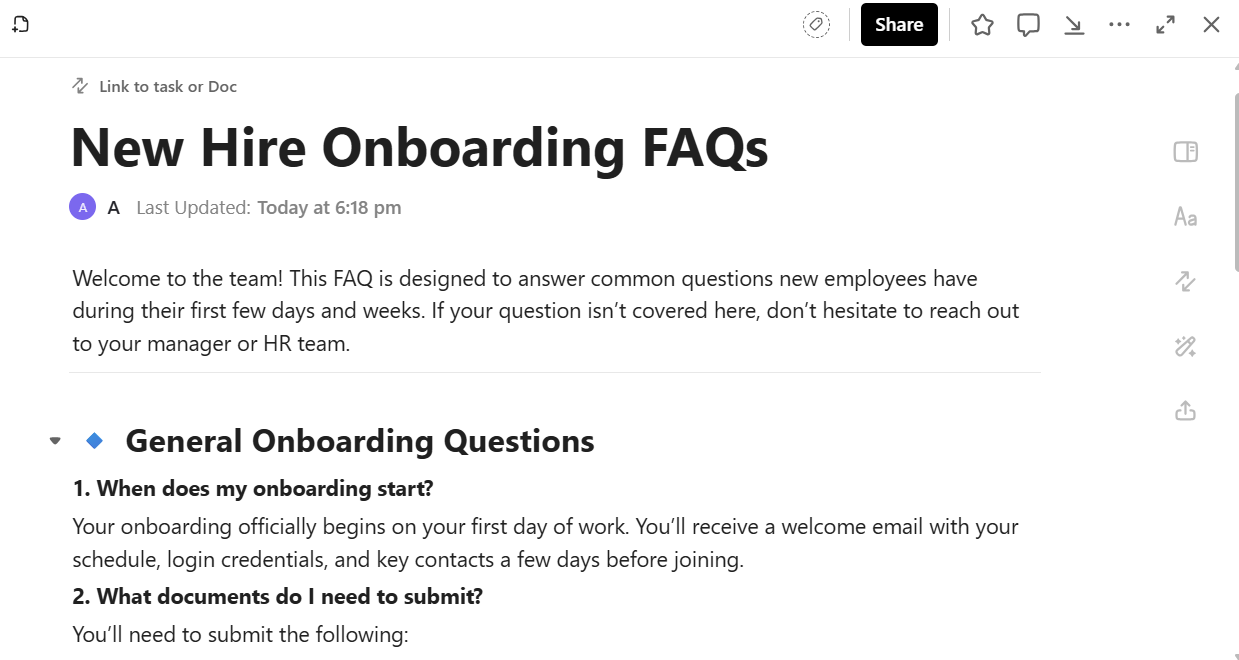
يمكنك أيضًا الإشارة إلى زملائك في الفريق لمساعدة الموظف الجديد مباشرةً في المستند. على سبيل المثال، إذا كان لديهم سؤال حول الوصول إلى VPN في مستند "دليل إعداد تكنولوجيا المعلومات"، فيمكنهم الإشارة إلى مدير تكنولوجيا المعلومات والحصول على إجابة في نفس المكان.
لست متأكدًا مما يجب تضمينه في مستندات الترحيب؟ يمكن أن يساعدك ClickUp Brain على البدء. على سبيل المثال، يمكنه إنشاء قائمة مراجعة مفصلة لليوم الأول تغطي كل ما يجب على الموظف الجديد إنجازه في يومه الأول. أو إذا كنت بحاجة إلى دليل ثقافي، فاطلب من الذكاء الاصطناعي صياغة أقسام عن قيم شركتك، وكيفية اتخاذ القرارات، وكيفية مشاركة الملاحظات.

هل تريد الاستفادة القصوى من ClickUp Brain؟ شاهد هذا الفيديو!
💡 نصيحة احترافية: استخدم قوالب دليل الموظفين لتوفر لك هيكلًا جاهزًا للأقسام الرئيسية مثل ساعات العمل وسياسات الإجازات وقواعد الاتصال وتوقعات الفريق. ما عليك سوى تخصيص التفاصيل الخاصة بشركتك ومشاركتها في مساحة عمل الترحيب.
تعيين مهام الترحيب
التأهيل ليس مهمة فردية، بل يشمل قسم الموارد البشرية وقسم تكنولوجيا المعلومات ومدير التوظيف والزميل والموظف الجديد.
باستخدام ClickUp Tasks، يمكنك تعيين المهام للأشخاص المناسبين وإشراك عدة زملاء في الفريق إذا لزم الأمر. يمكنك أيضًا إضافة مراقبين حتى يتمكنوا من مراقبة المهمة دون أن يكونوا المكلفين بها. وقم بتعيين مواعيد نهائية لكل مهمة حتى يلتزم الجميع بالجدول الزمني.
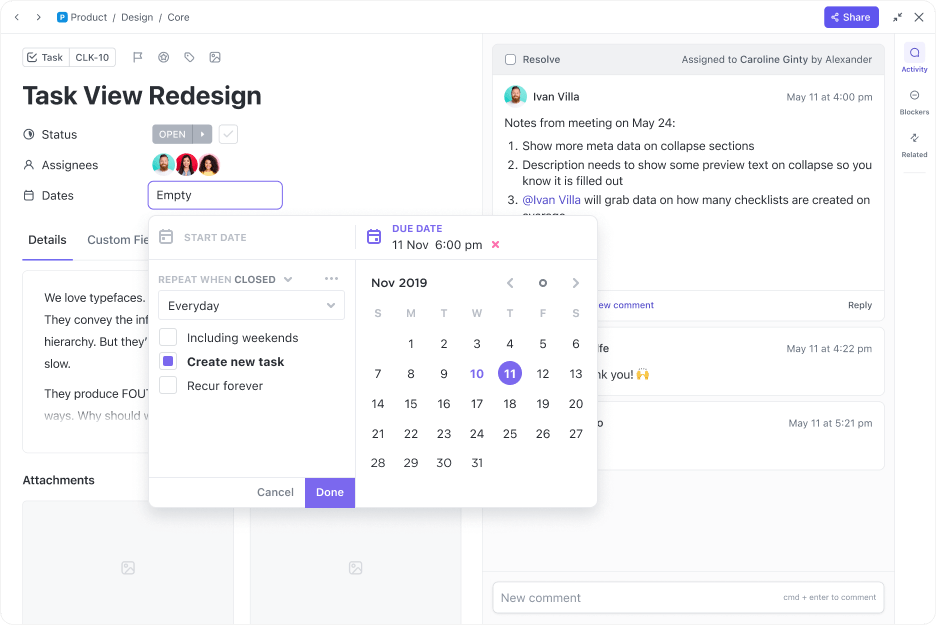
وبالنسبة للمهام التي تتكون من عدة خطوات، يمكنك إضافة قائمة مراجعة داخل المهمة نفسها. يمنح هذا الموظف الجديد خطوات واضحة وسهلة يمكنه اتباعها خلال رحلة الانضمام.
لنفترض أن المهمة هي "إعداد الوصول إلى الجهاز والنظام". فيما يلي شكل قائمة المراجعة:
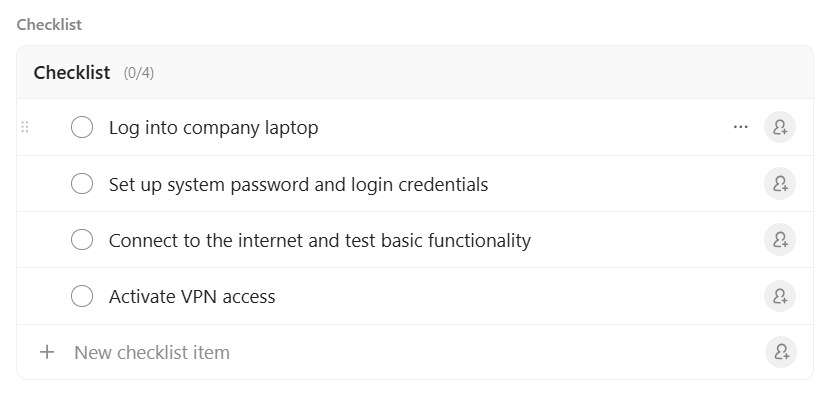
⚒️ نصيحة سريعة: إذا تأخرت مهمة ما، استخدم ClickUp Reminders لإرسال تذكير سريع إلى الشخص المكلف بها. بهذه الطريقة، لن تضطر إلى إرسال متابعات أو التساؤل عما إذا كان قد تم تفويتها.
تتبع تقدم عملية الترحيب
من السهل أن تفقد المسار عندما ينضم عدة أشخاص في وقت واحد. توفر لوحة معلومات ClickUp نظرة شاملة على برنامج الترحيب الخاص بك من خلال سحب البيانات من مهامك. يمكنك رؤية:
- من يشارك في الأسبوع 1 أو الأسبوع 2 أو 30-60-90 من عمليات التحقق
- ما هي المهام المتأخرة أو المكتملة أو المعرضة للخطر؟
- ما الذي لا يزال معلقًا من قسم الموارد البشرية أو قسم تكنولوجيا المعلومات أو المديرين
- مقارنة الجداول الزمنية للتأهيل بين الوظائف المختلفة
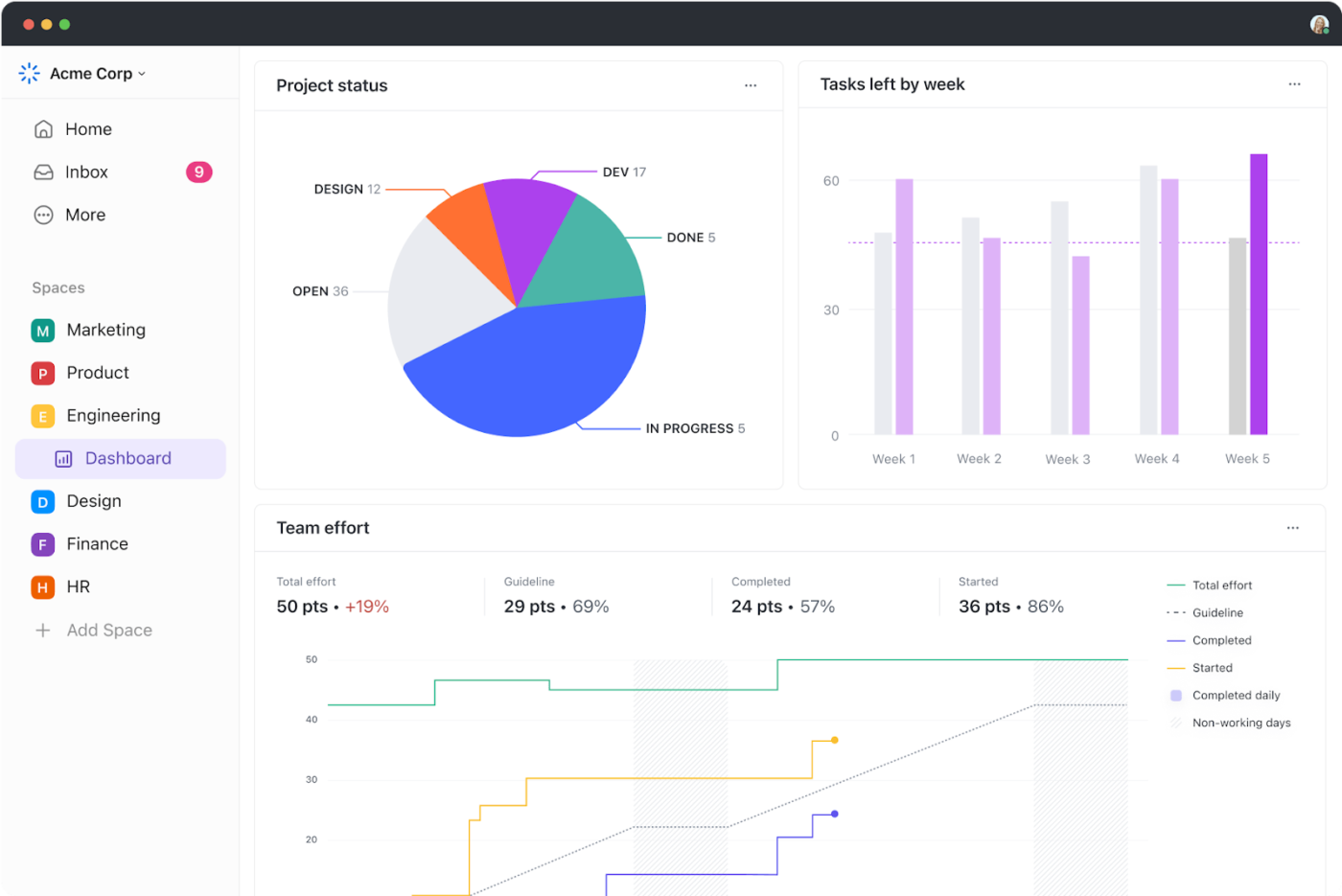
📚 اقرأ المزيد: أفضل قوالب تقييم الأداء لتعزيز نمو الموظفين
جدولة اتصالات سلسة
يؤدي الترحيب دون جدول زمني واضح إلى الارتباك والتأخير. يحل ClickUp Calendar هذه المشكلة من خلال تنظيم جميع الأحداث المتعلقة بالترحيب ومواعيد الاستحقاق في عرض مشترك. إذا تغيرت الخطط، ما عليك سوى السحب والإفلات لإعادة الجدولة، وسيقوم ClickUp بتحديث كل شيء على الفور — دون الحاجة إلى المتابعة اليدوية.

علاوة على ذلك، يعد ClickUp Chat المكان المثالي الذي يمكن للفرق من خلاله إجراء مناقشات سريعة ومركزة مباشرةً ضمن مهام الترحيب والمستندات والجداول الزمنية.
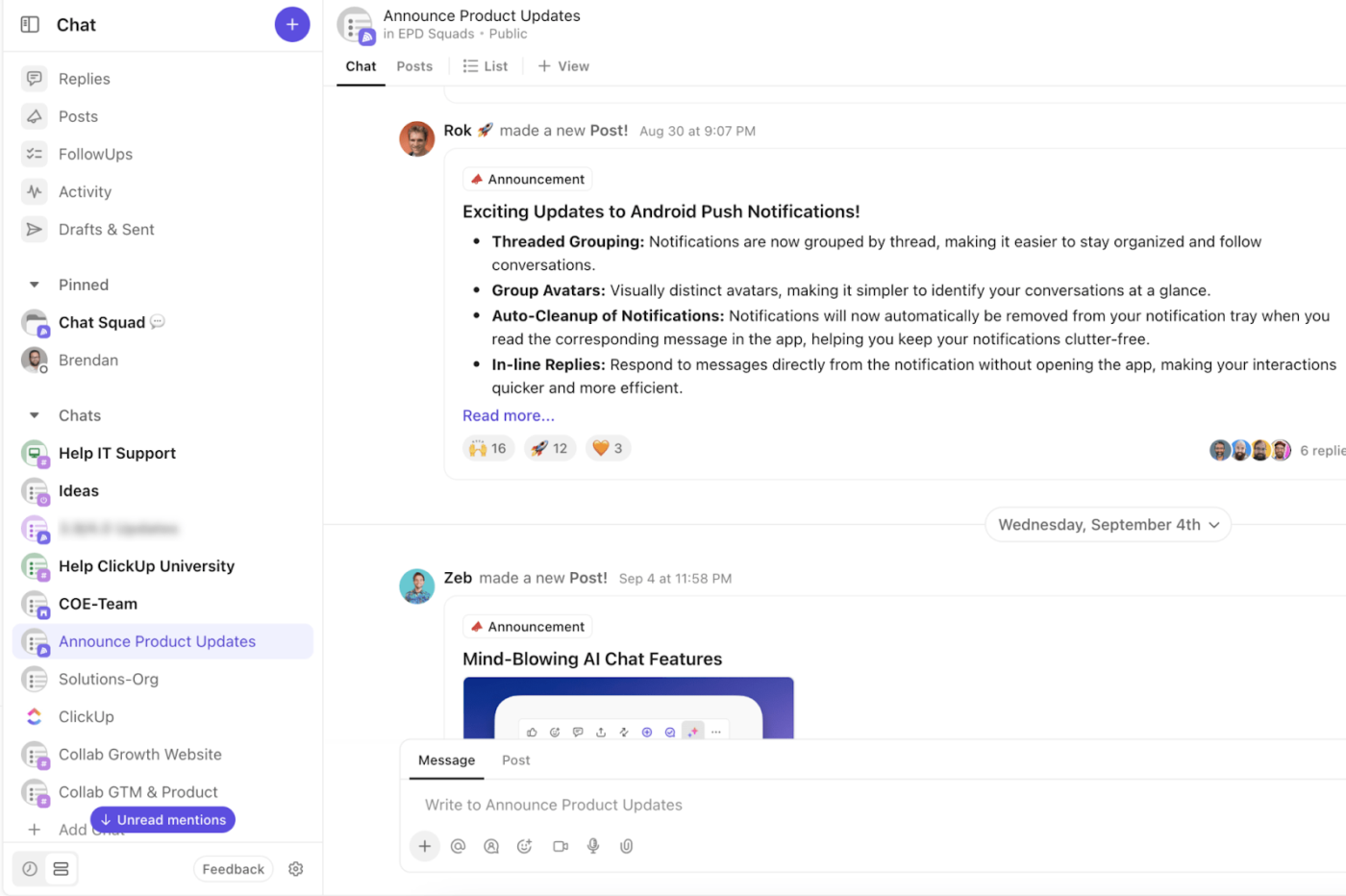
يمكنك أيضًا الإشارة إلى زملائك في الفريق للإجابة على أسئلة الموظفين، والربط مباشرة بالمهام أو المستندات، وحتى تحويل الرسائل (مثل "هل يمكنك جدولة موعد فحص جين بعد 30 يومًا؟") إلى مهمة بنقرة واحدة. وإذا تحولت المحادثة إلى محادثة أطول، يمكنك على الفور بدء مكالمة Zoom من نفس سلسلة المحادثة.
📮 ClickUp Insight: 92٪ من العاملين في مجال المعرفة معرضون لخطر فقدان قرارات مهمة مبعثرة عبر الدردشة والبريد الإلكتروني وجداول البيانات.
بدون نظام موحد لتسجيل القرارات وتتبعها، تضيع الرؤى التجارية المهمة في ضجيج العالم الرقمي. مع إمكانات إدارة المهام في ClickUp ، لن تقلق أبدًا بشأن هذا الأمر. أنشئ مهام من الدردشة وتعليقات المهام والمستندات ورسائل البريد الإلكتروني بنقرة واحدة!
أتمتة وتخصيص باستخدام قوالب جاهزة
يوفر ClickUp أيضًا قوالب للتأهيل لبدء عملية التأهيل دون الحاجة إلى البدء من الصفر.
يحدد نموذج ClickUp لتدريب الموظفين الجدد سير العمل في اليوم الأول والأسبوع الأول والأيام التسعين الأولى. تحصل على عرض قائمة منظم لتتبع المهام وعرض مستند تعاوني لمشاركة موارد التدريب مثل السياسات وقوائم المراجعة ورسائل الترحيب الحارة.
يتضمن النموذج ثماني حالات للمهام مثل "مهام مطلوبة" و"قيد التنفيذ" و"مطلوب مساعدة" و"جاهز للمراجعة". يمكنك بسهولة تتبع ما إذا كان الموظف الجديد قد بدأ في إعداد تكنولوجيا المعلومات الخاصة به، أو عالق في تقديم نماذج الموارد البشرية، أو ينتظر تعليقات على تدريب مكتمل.
ويتيح لك الحقل المخصص "أسبوع الترحيب" معرفة ما إذا كان عليهم إنهاء مهمة الأسبوع الأول المتمثلة في إعداد الأدوات قبل الانتقال إلى وحدات التدريب في الأسبوع الثاني.
📚 مكافأة: أفضل قوالب قوائم المهام المجانية
ابتكر طريقة قابلة للتكرار لتدريب الموظفين الجدد باستخدام ClickUp
قد تؤدي تجربة الترحيب غير المنظمة إلى شعور الموظفين الجدد بالضياع والانفصال قبل أن يبدأوا العمل. يساعد ClickUp في تبسيط العملية من خلال جمع كل شيء في مكان واحد منظم.
يمكنك مشاركة مواد الترحيب من خلال Docs، وتعيين المسؤوليات والتحقق من التقدم المحرز باستخدام Tasks، وإجراء محادثات سريعة مع أعضاء الفريق في Chat، والحفاظ على الاتساق باستخدام قوالب الترحيب المعدة مسبقًا. يمكنك أيضًا استخدام Dashboards للحصول على عرض في الوقت الفعلي للمهام التي تم إنجازها، والمهام المتأخرة، والمهام التي قد يواجه فيها أحدهم صعوبة.
هل ترغب في خلق تجارب انضمام متسقة ومنظمة؟ اشترك في ClickUp اليوم! 🙌
